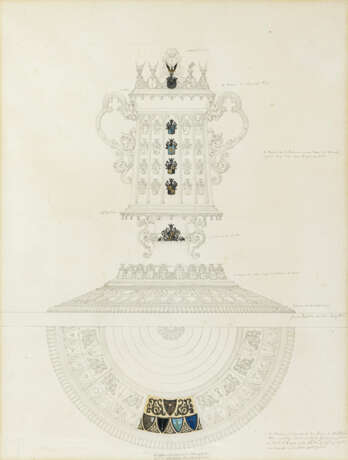ID 1022246
Lot 527 | Johann Georg Hossauer. Erinnerungspokal zum Fest "Zauber der weißen Rose"
Estimate value
€ 14 000 – 15 000
Erinnerungspokal zum Fest "Zauber der weißen Rose"
R. M. signiert und datiert "den 10ten July 1830". Bleistiftzeichnung, partiell aquarelliert, auf Velin (Wz. J. Whatman 1829). 60 x 44,3 cm. Gebräunt. Min. Knickfalten. Rahmen min. besch. (69 x 55,5 cm).
Johann Georg Hossauer (1794-1874) gilt als der führende Berliner Goldschmied der ersten Hälfte des 19. Jahrhunderts. 1819 gründete er eine "Fabrik für Waren aus Platina, Gold, Silber, Bronze, gold- und silberplattiertem Kupfer nach englischer Art." 1826 ernannte ihn Friedrich Wilhelm III. zum "Goldschmied Sr. Majestät des Königs". Fortan erhielt er vom preußischen Hof fast alle bedeutenden Aufträge, die bis zum Ende seiner Geschäftsaufgabe 1859 vergeben wurden.
Hossauers frühestes künstlerisches Hauptwerk ist ein neugotischer Prunkpokal, den er in drei Ausführungen, für die Kaiserin von Russland, den Herzog Carl von Mecklenburg-Strelitz und für König Friedrich Wilhelm III. von Preussen als Erinnerung an das Fest "Zauber der Weissen Rose" fertigte.
Das Fest fand anlässlich des Geburtstages der Kaiserin Alexandra Feodorowna am 13. Juli 1829 im Neuen Palais in Potsdam statt. Die Kaiserin, eine geborene Prinzessin Charlotte von Preussen (1798-1860) war die älteste Tochter König Friedrich Wilhelms III. und der Königin Luise. Seit ihrer Hochzeit mit Großfürst Nikolaus Pawlowitsch von Rußland (späterer Kaiser Nikolaus I.) trug sie den russischen Namen Alexandra Feodorowna. Das Fest wurde von ihrem Onkel Herzog Carl von Mecklenburg-Strelitz veranstaltet und gilt als eines der prunkvollsten und aufsehenerregendsten Feste, das je am preußischen Hof gefeiert worden ist. Es stand unter dem Motto "Zauber der Weissen Rose" in Anlehnung an die romantische Erzählung "Der Zauberring" von Friedrich de la Motte Fouqué, der während der Kindheit der Prinzessin Charlotte in Mode gekommen war. Ganz im Bann der romantischen Erzählung hatte man ihr damals den Kosenamen "Blanche Fleur" gegeben. Mit "tableaux vivants", sogenannten lebenden Bildern, wurde die Erzählung unter Einbeziehung der höfischen Gesellschaft nachgestellt.
Im Auftrag des Herzogs, des Kronprinzen und der Kaiserin und nach Entwurf von Karl Friedrich Schinkel (1781-1841) - der auch die Ausstattungen und Bühnendekoration entworfen hatte - fertigte Hossauer zwischen 1829 und 1831 im neugotischen Stil drei silberne, innen vergoldete, 69 cm große Prunkpokale in Form eines Humpen mit Plinthe, reich geschmückt mit den 73 emaillierten Wappen der königlichen und adeligen Teilnehmer. Zwei der drei Ausführungen des prunkvollen Deckelpokals haben sich erhalten: im Sommerschloss Peterhof bei St. Petersburg und im Neuen Pavillon, Schlossgarten Charlottenburg, in der Stiftung Preussische Schlösser und Gärten (SPSG) Berlin-Brandenburg.
Aus Hossauers Tagebüchern geht hervor, dass er an den drei Pokalen zeitlich parallel gearbeitet hat. Vorliegende maßstabsgerechte, detaillierte, großformatige Originalzeichnung schuf er nach Fertigstellung des ersten Pokals, sie war bis 2010 nicht bekannt. 1829 fertigte er eine erste eher skizzenhafte Zeichnung, die sich heute in der Plankammer der Stiftung Preußische Schlösser und Gärten (SPSG) in Potsdam befindet. Erhalten haben sich auch zwei Entwurfszeichnungen Schinkels im Kupferstichkabinett SMPK Berlin und in der Plankammer der SPSG Potsdam. (MJ)
Provenienz: Johann Georg Schickler (1793 - 1843). - Arthur de Schickler (1828 - 1919). - Marguerite Schickler de Pourtalès (1870 -1956). - Familie Duchet Duc dAlbufera (Erben der Letzgenannten), Chateau de Bizy. - Aus diesem Besitz 2010 vom jetzigen Einlieferer bei der Galerie Yann Alleée, Paris, erworben.
Literatur: Jonas, Melitta, Gold und Silber für den König - Johann George Hossauer (1794 - 1874) Goldschmied Sr. Majestät des Königs. Berlin 1998, S. 124-134, Prunk- und Schaustücke, Kat.Nr. 53, Abb. 42, 43.
| Artist: | Johann George Hossauer (1794 - 1874) |
|---|---|
| Auction house category: | Graphics 19th-20th century |
| Artist: | Johann George Hossauer (1794 - 1874) |
|---|---|
| Auction house category: | Graphics 19th-20th century |
| Address of auction |
Kunstauktionshaus Neumeister Barer Str. 37 80799 München Germany | ||||||||||||||
|---|---|---|---|---|---|---|---|---|---|---|---|---|---|---|---|
| Preview |
| ||||||||||||||
| Phone | 089 231710-20 | ||||||||||||||
| Fax | 089 231710-50 | ||||||||||||||
| Buyer Premium | 30% | ||||||||||||||
| Conditions of purchase | Conditions of purchase | ||||||||||||||
| Business hours | Business hours
|







